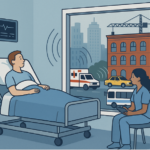By Michael Lentin
On Monday, Rep. Joseph Crowley announced a new bill that will help schools disturbed by train and subway noise to finally reach a peaceful solution.
One primary school in particular has fought to bring the issue to the limelight. PS85Q, in Astoria, Queens, sits a mere 50 feet from the MTA’s N/Q train, and in some classrooms, hearing the teacher has proven to be almost impossible for students.
The bill, known as the Peaceful Learning Act, will conduct research on how learning is affected by outer noises (such as trains), while funding Soundproofing solutions for affected schools. It will be modeled after the Federal Aviation Administration’s Noise Abatement Program, which works to provide Soundproofing solutions for schools near airports and jet runways.
In a YouTube video made by two PS85Q student’s parents, Rebecca Bratspies of the CUNY Center for Urban Environmental Reform sits by a Window in a second grade classroom, speaking to the camera as a train rolls by just 16 yards away. As she speaks, she shows firsthand that the viewer is unable to hear what she’s saying due to the loud, rumbling subway noise. She also holds a noise detector, which reaches a shocking peak of 95 decibels during the train’s passing.
For context, normal speaking with an inside voice has an estimated 50 decibels; 90 decibels (almost double this) is proven to cause damage from prolonged exposures of 8 hours or more—typically around the amount of time the students spend at school each day.
The students have even been taught the hand gesture of a peace sign, used to signal that the other person can’t be heard. Students are instructed to hold up the peace sign until yet another train has finished rolling by.
While a train passing by a few times a day may seem like an arbitrary issue, the video points out that a train passes every 6 minutes during the day, and every 2 minutes during the morning rush hour. Each train takes 30-40 seconds to pass. Thus, in the mornings, students are faced with 30 seconds of train time, followed by only a minute and a half of quiet, only to bring another 30 seconds of train racket— it’s a vicious cycle.
The school’s staff has already brainstormed possible solutions to the issue:
• Installing Soundproof Windows and acoustic tiles
• Installing rubber wheels on the trains (many cities in the world already do this)
• Cushioning the rails with rubber pads (implemented in Inwood, a northern Manhattan neighborhood, as early as 1975, they point out)
• Erecting a sound barrier between the subway and the school
Research has found that constant white noise and background noise can induce stress, hinder optimal brain function, and cause barriers in a person’s ability to focus and retain information. Thus, a school is the last place in which noise pollution should be tolerated.
The video pleads: “We’re asking our elected officials to stop ignoring this problem, and to allocate funds to end this harmful and unjust noise pollution.”
CitiQuiet’s mission is to promote peace and quiet for all who suffer from the damaging effects of noise pollution through our Soundproofing Window Systems, and we are in full support of the Peaceful Learning Act.



